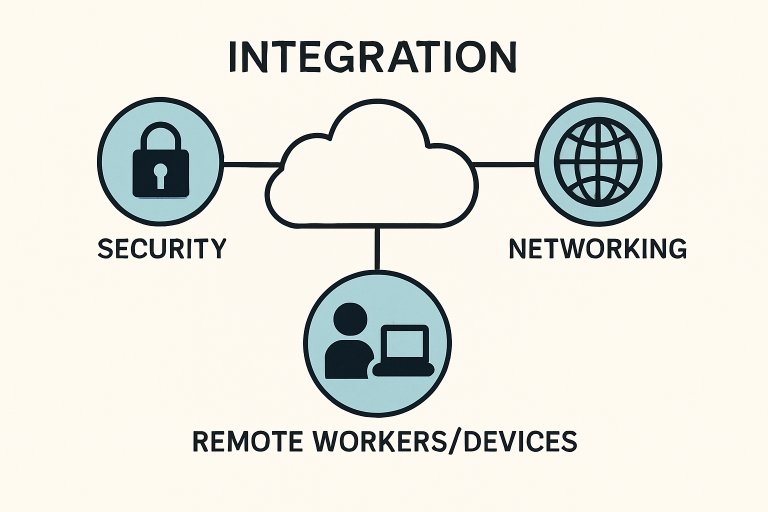Key Takeaways
- SASE merges network and security services into a single, scalable cloud-based solution.
- The model is built on zero-trust principles, streamlining security and compliance for distributed teams.
- SASE adoption is surging due to the rise of hybrid work trends and the evolving threat landscape.
- Careful planning, effective change management, and strategic provider selection are essential to a successful transition.
In an era defined by widespread digital disruption, enterprises must prioritize both high-performance networking and ironclad security. Secure Access Service Edge, or SASE, delivers an innovative approach by merging these functions into one cloud-native service model. As businesses expand into hybrid and remote work, implementing a top SASE solution has become increasingly vital for safeguarding sensitive data and supporting agile operations.
SASE combines robust networking technology with advanced security frameworks, offering enterprises consistent protection and optimized network access across global locations. This all-in-one approach enables organizations to unify policy management, minimize complexity, and keep up with the demands of today’s fluid business environments.
As organizations embrace these capabilities, the need for adaptive, centrally managed network security has never been higher. For in-depth context on how SASE is reshaping digital infrastructure, enterprises can look to resources from CSO Online, which explores the evolution and importance of secure cloud access architectures.
Understanding SASE and Its Core Components
SASE represents a paradigm shift in network architecture by converging wide-area networking (WAN) and cloud-delivered security services. At its core, SASE integrates key elements, including secure web gateways (SWGs), firewall as a service (FWaaS), cloud access security brokers (CASBs), and zero-trust network access (ZTNA). This framework provides a unified platform for user authentication, traffic management, and content filtering—regardless of users’ locations or device types.

By merging these functions, SASE eliminates the need for disparate on-premises tools, providing IT teams with clear visibility and granular control over their network. A central feature is the enforcement of zero-trust security, where each access attempt undergoes strict verification. This helps mitigate risks posed by external threats and insider vulnerabilities in modern hybrid work models.
Benefits of Implementing SASE
- Enhanced Security: SASE’s zero-trust policies and security components work in tandem to ensure that only authenticated and authorized users gain access to resources, regardless of their physical location.
- Optimized Performance: Built-in SD-WAN capabilities intelligently route network traffic, reducing bottlenecks and optimizing connectivity for critical cloud and SaaS applications.
- Simplified Operations: With management functions consolidated in a single pane of glass, IT teams can streamline policy deployment, enhance compliance, and respond quickly to emerging risks.
- Cost Efficiency: Cloud-native deployment models enable organizations to minimize hardware investments and benefit from elastic scaling as their networking demands fluctuate.
Growing Adoption Among Enterprises
Recent industry reports indicate a significant increase in SASE interest among global businesses. According to a survey from Hughes Network Systems, as many as two-thirds of organizations are evaluating SASE to meet the challenges posed by distributed teams and evolving threat environments. The study underscores that employees, now working from more locations and devices than ever, are frequently identified as the primary risk to enterprise security—making solutions like SASE critical to adequate protection.
To learn more about best practices for evaluating and implementing SASE, refer to the credible insights offered by Gartner’s Hype Cycle for Network Security, which provides an objective analysis of security adoption trends.
Real-World Implementations
A growing number of organizations, ranging from small businesses to large enterprises, are adopting Secure Access Service Edge (SASE) frameworks to enhance data security and better support hybrid and remote work environments. SASE consolidates network security and connectivity into a single cloud-based system, reducing complexity and improving visibility across all access points. For example, NETGEAR’s enterprise-grade cybersecurity solution for small and medium-sized businesses demonstrates how SASE enables centralized management, real-time monitoring, and consistent protection without requiring extensive internal IT teams. This is especially valuable for smaller companies, which are frequently targeted because of perceived vulnerabilities and limited security budgets. By delivering enterprise-level safeguards in a scalable and manageable form, SASE empowers organizations to protect employees, devices, and sensitive data while maintaining operational flexibility and efficiency.
Challenges and Considerations
- Integration Complexity: Migrating legacy systems into a SASE environment requires significant planning and coordination to minimize service disruptions and ensure seamless integration.
- Vendor Differentiation: SASE offerings vary significantly in terms of sophistication, feature scope, and support. Enterprises should rigorously evaluate providers for alignment with their security and operational priorities.
- Change Management: SASE transformation involves organizational shifts. Employee education, clear communication, and robust planning are essential for a seamless transition.
Future Outlook
The SASE market is poised to expand as organizations continue to migrate workloads to the cloud and support distributed users across various environments. Moving forward, vendors are investing in more advanced, AI-driven threat detection and automated response capabilities to identify unusual behavior and prevent attacks before they escalate quickly. Deeper integrations with XDR platforms will create more unified visibility across endpoints, networks, and applications, streamlining security management for IT teams. At the same time, enhanced compliance features will help businesses meet stricter data privacy and regulatory requirements with greater confidence. As hybrid work becomes the norm and remote access demands increase, SASE will provide a flexible and scalable foundation that adapts to evolving operational needs. Ultimately, organizations adopting SASE can expect stronger security, simplified management, and improved performance across their digital ecosystems.
Conclusion
SASE network solutions have emerged as a critical framework for organizations that must balance high-performance connectivity with stringent security demands across distributed environments. In a world where employees work from multiple locations and applications increasingly reside in the cloud, SASE provides a cohesive approach by merging networking functions, such as SD-WAN, with security services like zero-trust access, firewalling, and threat prevention. This cloud-native architecture allows policies and protections to follow users and devices wherever they operate, reducing complexity and eliminating the need for multiple standalone tools. By centralizing management and automating security enforcement, SASE improves visibility while streamlining IT workloads. Adopting SASE not only enhances immediate protection and user experience but also positions businesses to scale efficiently, remain agile, and maintain resilience against evolving cybersecurity threats.






